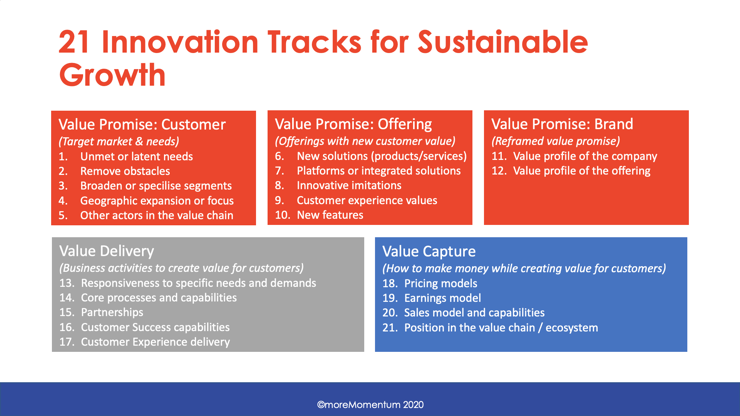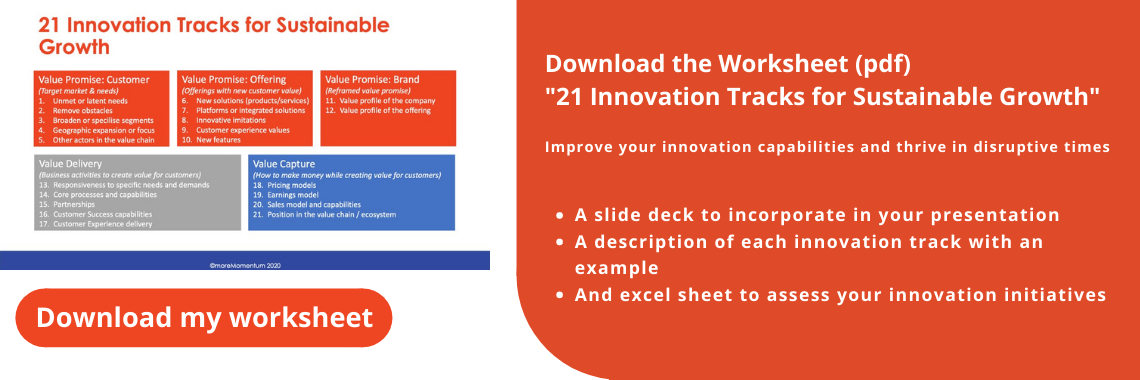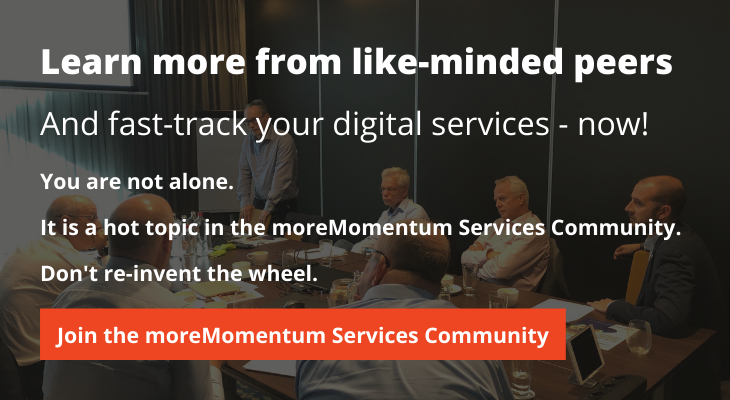Leading manufacturers cover a rich and wide scope of service innovations to successfully find opportunities increase value for their customers and business.
Summary
Manufacturers with a narrow innovation focus miss many opportunities, see more innovations fail, often see that competitors do exactly the same thing and struggle to turn their innovations into growing revenues and margins.
Leading and successful manufacturers cover a much wider scope of innovations than those that stagnate and fall behind competition. They actively search for opportunities to improve the value they promise their clients, how they deliver the value and how they capture part of the value.
They find and launch more innovations for growth.
Sounds like a good recipe, doesn’t it?
The Problem: Too narrow innovation
Many manufacturers have a too narrow focus on their innovations. Their dominant focus is on improving features and functionality of the products they sell. An increasing portion of the manufacturers also improve their services, but are still focusing on break-fix and maintenance services.
There are major disadvantages of the narrow innovation focus:
- Companies miss many opportunities to better serve their clients and grow their business
- Most innovations are not a complete solution, miss crucial aspects and therefore fail
- If clients do appreciate the new value, they often have the buying power to benefit from this new value without paying more for it
- For competitors it is easy to recognise the innovations and do exactly the same (or better), hence, commoditise the new capabilities and value even before the investment is earned back
As a result, they not only fall behind competition. In today’s rapidly changing industries, they ultimately run the risk of be pushed down the “food chain”, stagnate or even become obsolete.
This is pretty frustrating, but does not have to be like that.
How many manufacturers struggle to grow with IoT
A common struggle is to drive growth and monetise new remote capabilities.
Most manufacturers focus predominantly on predictive maintenance, remote diagnostics and remote resolution. The aim is to increase the value they offer to clients by improving uptime of their equipment and the resolution time if a failure occurs.
They encounter the following typical challenges:
- Uptime is already quite high, so there is not much room for improving the value for clients. If uptime is already 95%, how much value will it bring your client to increase uptime to 96-97%?
- Clients recognize that you will be able to deliver maintenance services at a lower cost, so they may actually expect to pay less, not more.
- Competitors are working on exactly the same, so there is no opportunity to differentiate
- Clients fear a myriad of IoT networks, platforms and having their data flow to external parties. Every brand and manufacturer they work with is asking for the same.
Clients start looking for a common infrastructure and services from neutral service providers.
As a result, manufacturers invest a lot, see little value coming in return and see a declining interest for business innovation from senior stakeholders in their company.
Solution: Search along 21 innovation tracks
Leading and innovative manufacturers have a pretty broad range of areas in which they innovate for growth. They are more open to new domains, new business models and new perspectives which enables them to adapt and thrive in rapidly changing industries.
In our research, we have identified 21 innovation tracks for growth, spread over 3 clusters. You can thrive in today’s disruptive world and achieve sustainable growth by widening your scope of innovation along these 21 tracks and by making strong and coherent combinations in each innovation.
Just like the leading innovators, make it a habit to embed these 21 tracks firmly in your innovation strategy:
- Actively search for growth opportunities
- Along 21 innovation tracks
- And enrich each innovation idea by combining a few innovation tracks


The 3 clusters of the 21 tracks are:
- The value you promise to clients
Which problems or needs do you solve for which customer segments?
Your growth opportunities are in solving more or other problems of your existing clients and expanding the market you serve.
Alternatively, instead of expanding on scope and market, you could also specialise more in a specific niche of customer segments and needs and become the market leader in that niche.
This cluster of innovation tracks also includes developing your brand to better articulate and expose the value you provide.
- How you deliver the value
Which activities and capabilities do you need to deliver the promised value to your clients?
Your growth opportunities are in building and improving the capabilities to deliver the value in an effective, efficient and consistent way, so clients get and see the value.
- How you capture part of the value
Which portion of the value you create and deliver do you capture? So how and how much are you being paid for the value you deliver?
This involves your pricing model, earnings model and your position in the value chain.
How Apple became invincible
Apples success cannot only be attributed to fashionable phones and great apps. Apple maintains a pretty wide scope of innovations and makes strong combinations of the 21 tracks which enables them to:
- Launch desirable and irresistible products, apps and services.
- Offer tangible and intangible value.
- Have many revenue streams, including from app-builders.
- Maintain a unique position compared to competitors.
A few examples of how the various tracks are embedded in their strategy:
- There was a latent need of easy availability of tools and information and easy access to music (track 1). A lot was already available for the techies, but not for the mass market until Apple made this easy and readily available (track 2).
Various manufacturers have offered something similar before, but Apple made it a commercial success by learning from the previous attempts of others what was needed for success (track 8).
- Apple developed an ecosystem of products and services with seamless integration as well as the Appstore (track 7). Other app-developers can offer their apps in the Appstore as well (track 15), but have to comply with Apple’s requirements. They also need to pay part of their license fees to Apple (track 19). As the app-builders are replaceable and the Apple eco-system is not, Apple can afford to ask pretty significant fees (track 21 and 18).
- Apple’s brands is far beyond “great products”. It is much more about lifestyle, ease, fashion and desire (track 11 and 12).
Successful and innovative companies always have these three clusters – value promise, value delivery and value capture – aligned and integrated. To achieve this, they:
- Actively search for innovation ideas and growth opportunities along all of the 21 innovation tracks spread over the 3 clusters.
- Maintain a healthy and balanced portfolio of innovations covering all 21 innovation tracks.
- Enrich each innovation project to cover multiple tracks
- Avoid as much as possible to have an innovation initiative which only covers one of the innovation tracks.
As a result, they have:
- Higher growth rates.
- Higher profit margins.
- Clients which are fans.
- More innovations which are a success.
Leaving their competitors wondering how they did this.
Back to IoT – the opportunity
Once you have the sensors in your equipment, the infrastructure for connectivity and data and the capabilities to turn data into valuable insights, there are many opportunities to enrich your innovations and business model and hence dramatically improve the potential for your clients and your own business.
To mention only a few:
- Your clients are on a journey of becoming more digital and data driven in many of their processes. This is a challenge with many unknown domains, unanswered questions and uncertainties.
How can you identify these new needs (track 1) and reduce the complexity and uncertainty for your clients (track 2)?
- With the data and intelligence you develop on the back of these data, you can help your clients to reduce usage of energy and materials, improve efficiency and productivity, develop their products and shift their core business (track 6).
This could start with assessment and benchmarking services, evolve in consulting and training services and further grow into business outsourcing services.
For example, Fresenius does not only sell the instruments for kidney dialyses, but also runs entire kidney dialyses departments in hospitals, including the staff treating the patients.
- Part of this journey is also advancing your brand from being a product manufacturer to a solutions provider and being known for what problems you solve. (track 11 and 12).
For example, Caterpillar helps clients achieve operational excellence through advanced services covering asset management, project planning, fuel consumption etcetera.
- Particularly for component manufacturers, you have the opportunity to develop unique intellectual property with which you can improve the overall performance of bigger systems of OEM’s. This will make you less replaceable and increase your ability to secure your margins from the OEM (track 21 and 18) – like Intel Inside.
Maybe you can even do business with the end-client buying assets from the OEM (track 19). An example is how Rolls Royce does not sell its airplane engines to the airplane builders (OEMs) but to the users of the airplanes.
- For most innovations, you will need to develop new capabilities, processes, competencies and tools to deliver these new values in an efficient way (track 14).
- As your business becomes more focussed on outcome and starts building more recurring revenues, you will need to develop your sales model as well (track 20), with more emphasis on onboarding, driving and demonstrating customer success, improving customer life time value and step-by-step growing the business with your clients by upselling and cross-selling
Conclusion
For sustainable success in today’s rapidly changing world, there is no single silver bullet. A great product or great service will not bring much value.
To thrive in these disruptive times, you need diversity in your business innovation with initiatives in different innovation tracks as well as initiatives with a rich and coherent set of innovation tracks.
That way, you will launch innovations which:
- Provide clients a complete, remarkable and desirable solution
- Are hard to replace by other actors in the value chain, like OEM’s or system integrators.
- Cannot be easily copied by competitors.
- Your clients will love to pay for.
If you want to take your business innovation to the next level, I would like to recommend you and your team to:
- Assess your portfolio of innovation projects along the 21 innovation tracks. How well are the 21 tracks covered?
Download the worksheet 21 Innovation Tracks for Sustainable Growth
- Enrich each innovation idea and project by adding a few more innovation tracks to it.





